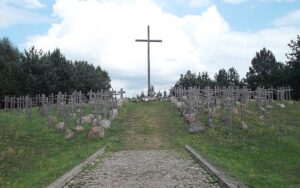
Monument – symbolic grave of the victims of the Augustów Roundup in Giby. CC-BY-SA-4.0Self-published workPhotos by Witia
Staszek Hoffman’s father was first deported by the Soviets from Sztabin back in 1939. He was the commander of the police station in Tykocin. He did not return. On 13 April 1940, the Soviets came for Staszek’s mother Apolonia and sister Irenka. The Soviets locked them in a wagon standing at Augustów station, with doors secured with barbed wire. In a cart, they then brought 14-year-old Staś, whom they wanted to join his mother and sister. They did not know that the boy suffered from a rare, severe motion sickness and that such a long journey would put him at risk of death. His mother desperately explained this to the Soviets, who finally relented under the pressure of the crowd gathering around them.
Staszek was taken to his aunt’s house. His mum and sister spent the next six years working at a Soviet kolkhoz in the North Kazakhstan Region. When they returned, Staszek was gone. The Soviets had taken him away on 14 July 1945, during the Augustów Roundup, and murdered him in an unknown location, probably shortly after 20 July, along with at least around 600 other inhabitants of north-eastern Poland. For several decades after the war, families referred to the victims of the roundup as “missing” because they did not know their fate.
Many believed that they had been deported to Sybir and that they would one day return. It was not until 2011, when Nikita Petrov, a researcher from the (now illegal) Russian Memorial International Society, revealed a document incontrovertibly confirming that they had been murdered at an as yet undetermined place and time.
In 2015, the Sejm of the Republic of Poland established 12 July as the “Day of Remembrance of the Victims of the Augustów Roundup”.



